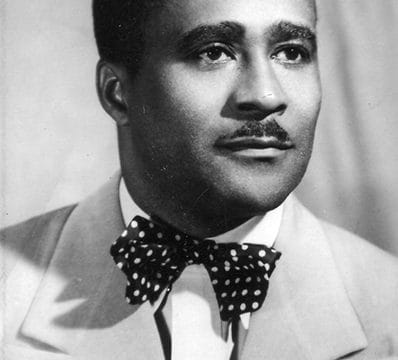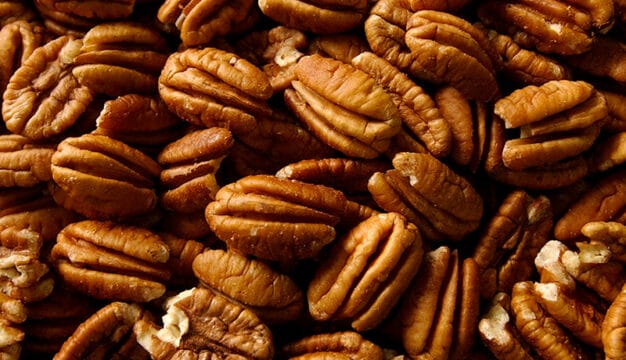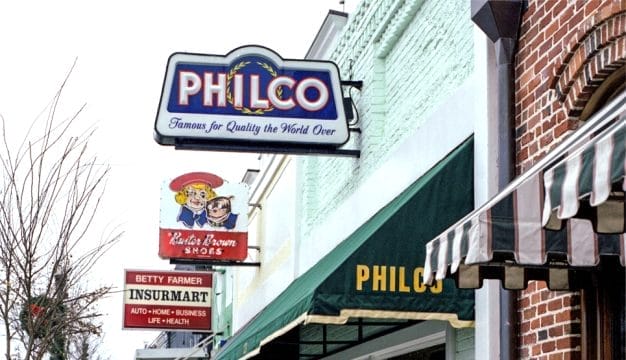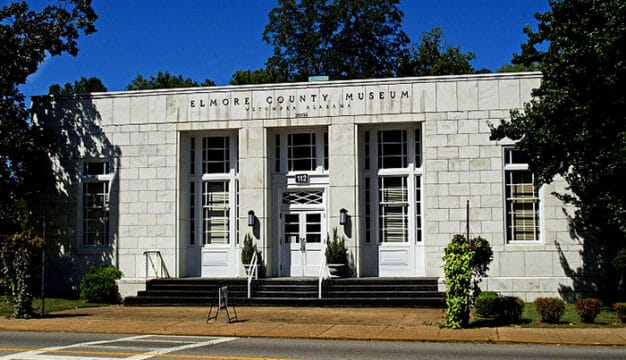USA Archaeology Museum
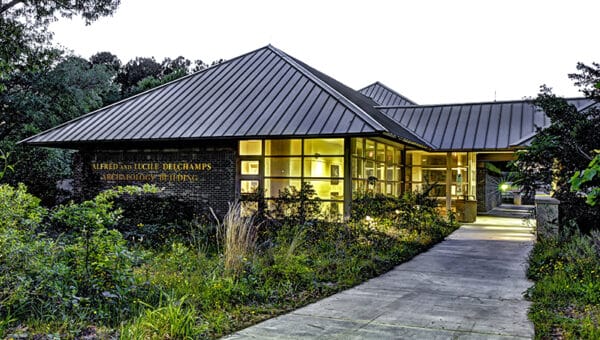 USA Archaeology Museum
The Archaeology Museum is located on the campus of the University of South Alabama (USA) in Mobile, Mobile County. Some 12,000 years of Gulf Coast prehistory and history are presented in a series of dioramas focusing on Native American cultures, European exploration and settlement, and African Americans in the Civil War era. The museum also hosts temporary exhibits on various aspects of history and serves the university community, area K-12 educators, and the general public through educational programming and special exhibits. The 8,000-square-foot museum is housed in the Alfred and Lucile Delchamps Building located in the heart of the USA campus. The modern, two-story facility opened in October 2012.
USA Archaeology Museum
The Archaeology Museum is located on the campus of the University of South Alabama (USA) in Mobile, Mobile County. Some 12,000 years of Gulf Coast prehistory and history are presented in a series of dioramas focusing on Native American cultures, European exploration and settlement, and African Americans in the Civil War era. The museum also hosts temporary exhibits on various aspects of history and serves the university community, area K-12 educators, and the general public through educational programming and special exhibits. The 8,000-square-foot museum is housed in the Alfred and Lucile Delchamps Building located in the heart of the USA campus. The modern, two-story facility opened in October 2012.
The foundation for the museum content is the fieldwork, research and scholarship conducted by the University’s Center for Archaeological Studies (CAS). Since its inception in 1992, CAS has conducted field studies and researched hundreds of sites in southwest Alabama and surrounding areas. Together, the organizations promote archaeological study of and appreciation for the region’s prehistoric and historic past, disseminate information about the region’s archaeology, and preserve archaeological evidence of the region’s past for future study, use, and enjoyment. Both the museum and CAS operate under the auspices of the Department of Sociology, Anthropology, and Social Work in the College of Arts and Sciences, with exhibits developed by archaeology faculty and staff and outside experts. The construction of the museum building was funded by a number of donors including Alfred and Lucile Delchamps, the J. L. Bedsole Foundation, and the USA National Alumni Association. Current funding for selected educational programming is provided by the Daniel Foundation of Alabama.
The museum features several galleries that underscore the importance of the region’s rich prehistoric and historic past and the role archaeology plays in preserving that heritage. It also contains temporary exhibit space, a laboratory for archaeological research and analysis, and curation rooms for artifacts. The grounds include a native-plant garden that features hundreds of species of native wildflowers, shrubs, vines, and trees from diverse habitats. The garden also has an amphitheater where educational programming and community events take place.
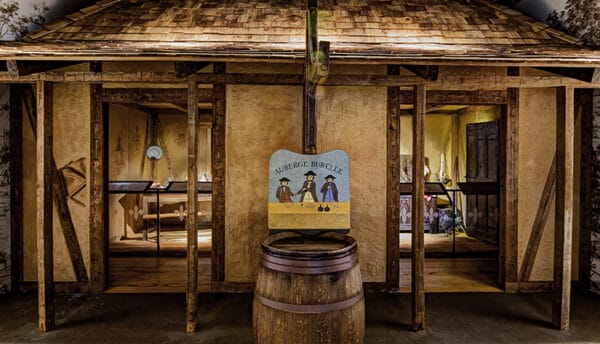 Colonial French Inn Exhibit
The main museum gallery space hosts several small permanent exhibits highlighting Gulf Coast history and prehistory, with artifacts drawn primarily from archaeological excavations conducted by the University of South Alabama and CAS over the past three decades. The main exhibit gallery space houses multiple “rooms” covering different time periods and subjects in Alabama archaeology, with complementary mural work provided by artists Dean Mosher, Jason Guynes, and Sheila Nguyen Overstreet. Exhibits are enhanced with life-size human models based on contemporary and historical figures.
Colonial French Inn Exhibit
The main museum gallery space hosts several small permanent exhibits highlighting Gulf Coast history and prehistory, with artifacts drawn primarily from archaeological excavations conducted by the University of South Alabama and CAS over the past three decades. The main exhibit gallery space houses multiple “rooms” covering different time periods and subjects in Alabama archaeology, with complementary mural work provided by artists Dean Mosher, Jason Guynes, and Sheila Nguyen Overstreet. Exhibits are enhanced with life-size human models based on contemporary and historical figures.
Historic period exhibit spaces include the popular “French house” area of the museum, which features text and displays highlighting excavations conducted at the site of Old Mobile. The exhibit underscores the uniqueness of Gulf Coast colonial-era architecture by allowing visitors to walk through and immerse themselves in a period French inn. Artifacts on display include bricks, roof tile fragments, eating utensils, and tableware, as well as remains of animals from the site of colonial-era Mobile and surrounding areas. The “Archaeology of Us” exhibit recreates the experiences of Lucrecia Perryman, an African American midwife living and working in post-Civil War Mobile through artifacts recovered from a well during excavations conducted at her home in 1993.
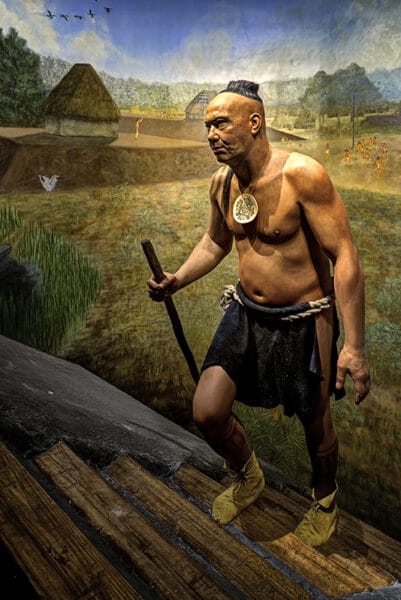 Mississippian Chief
The prehistoric-era exhibit displays include “A Day at Bottle Creek,” which depicts life at the site of the Mississippian-era Bottle Creek site, where visitors enter a reconstruction of a chieftain’s house that would have sat atop a large mound. A male chief ascends the mound by log steps, and a mural of town highlights additional mounds, houses, and the surrounding landscape. Prehistoric environmental changes, foods both wild and domesticated, and changes in stone tool technology and ceramic vessels are also showcased in a wide variety of displays in additional galleries.
Mississippian Chief
The prehistoric-era exhibit displays include “A Day at Bottle Creek,” which depicts life at the site of the Mississippian-era Bottle Creek site, where visitors enter a reconstruction of a chieftain’s house that would have sat atop a large mound. A male chief ascends the mound by log steps, and a mural of town highlights additional mounds, houses, and the surrounding landscape. Prehistoric environmental changes, foods both wild and domesticated, and changes in stone tool technology and ceramic vessels are also showcased in a wide variety of displays in additional galleries.
Many exhibit areas are also enhanced with video displays that introduce visitors to ground-penetrating radar and other scientific techniques used by modern archaeologists, stone-tool manufacturing, and changes in the environment through time. A large map showing impacts to archaeological sites in the area and a stratigraphy wall underscore the impacts human activities have on our shared heritage. The History Theater shows rotating short films on archaeological topics or temporary exhibits.
In addition to its permanent displays, the museum hosts temporary traveling exhibits often tied to the University of South Alabama’s Common Read/Common World initiative. The initiative seeks to facilitate important conversations regarding contemporary issues through the shared experience of reading the same book. Past temporary exhibits have highlighted noted documentary photographer James “Spider” Martin and his historic photographs of the Selma to Montgomery March. Another captured Washington State photographer Matika Wilbur’s quest to document 562 federally recognized Native American tribes. The museum also exhibited artwork from the “Half the Sky” movement, which aims to raise awareness about the worldwide oppression of women and increase opportunities for women and girls.
The Archaeology Museum regularly hosts public lectures and family programs, K-12 student tours, teacher workshops, and meetings for members of the university community and general public. The museum also participates in outreach events and regional festivals, including the Alabama Coastal Bird Fest and Mobile International Festival. The facility is administered by a director who oversees a staff consisting of a full-time education curator and a small handful of university student assistants and interns. The museum welcomes around 6,000-7,000 visitors per year, including hundreds of Alabama school children.
